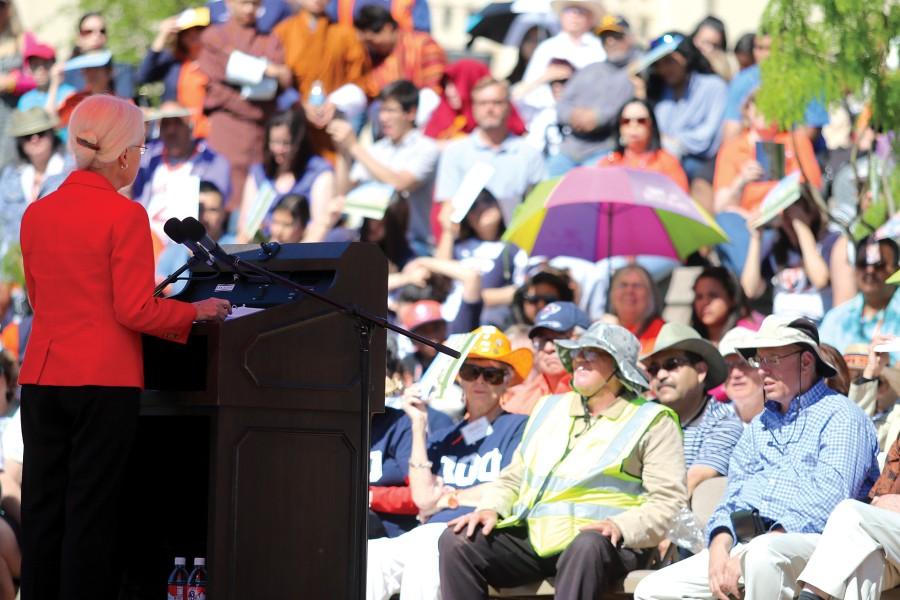When you first graduated from college, how did you know what to do after that?
With encouragement from my professors at St. Louis University, to consider going to graduate school. I had my eye on the University of Wisconsin because it was highly regarded for its programs in Spanish language and literature, which is what I’d studied at SLU. At the suggestion of one of my professors, I also applied for a Fulbright Fellowship to spend a year in Brazil, but didn’t think I’d actually be selected, so I didn’t give that possibility much thought. When I received a letter from my congressman informing me that I’d been awarded the Fulbright, I was shocked and somewhat frightened at the prospect, especially since I’d never flown on an airplane or lived away from home before! Happily, I gathered my courage and traveled to Brazil, where I spent the most exciting and intensive learning experience of my life–totally transformative!
What is your advice for students graduating this semester?
Be confident that the preparation you’ve received at UTEP will enable you to be successful in achieving your biggest dreams. Be bold in pursuing opportunities that may initially seem daunting to you.
What is the biggest difference you see in today’s students from when you first became president in 1988?
There are nearly 9,000 more UTEP students today than there were in 1988, and they more faithfully reflect the demographics of the surrounding region than they did then. UTEP students in 2015 set higher aspirations for themselves—graduate/professional schools and career options—and they are far more actively engaged in seeking to capitalize on the rich range of opportunities for professional and personal development offered to them on today’s UTEP campus.
What efforts are being done to increase graduation rates?
Traditional graduation rates, which are a vestige of mid-20th century higher education, are highly misleading measures of the performance of large public universities like UTEP, because their calculation requires that students start and complete their degrees at the same institution. At UTEP, this method of calculating graduation rates means that 70 percent of our graduates—including all our transfer students—don’t get counted, simply because they didn’t start their bachelor’s degrees as full-time freshmen at UTEP.
Given the fact that 79 percent of UTEP students make less than $19,000 a year, do you think increasing tuition will decrease access to education?
No, I don’t think that modest increases in tuition would have that impact because, through our UTEP Promise program, students whose family incomes total $30,000 or less, are guaranteed financial aid that eliminates any out-of-pocket cost of attendance.
What progress has been made toward achieving tier-one status, and why is this accomplishment important for UTEP?
We’ve made huge progress. We set two tier-one goals: $100 million in annual research expenditures and 100 doctoral degrees conferred annually. Over the past several years, we’ve already exceeded the 100 doctoral degrees goal, and our annual research expenditures now total more than $90 million, so we’re getting very close to achieving that goal as well.
Since you became president, there have been major, significant changes at UTEP, such as an increase in enrollment, research expenditures, the construction of new buildings, etc. What future do you foresee for UTEP? What legacy do you wish to leave behind?
I see UTEP as a national model for educating historically underrepresented students—Hispanics, first in their families to pursue higher education, and those who have very limited financial means. The disparity in higher educational attainment between low and high socioeconomic quartiles in U.S. society has grown wider over the past 40 years. Fewer than 10 percent of U.S. young people in the lowest socioeconomic quartile today earn a bachelor’s degree, while in the highest quartile, bachelor’s degree attainment has risen to nearly 80 percent. UTEP’s access and excellence mission has become well known for successfully addressing that absolutely unacceptable socioeconomic disparity and for re-shaping the national narrative on the role of U.S. public higher education in the 21st century. To me, that will be, far and away, UTEP’s most critically important and lasting legacy.











